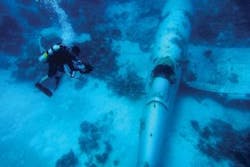Underwater robots search for World War II pilots, aircraft
An organization called the BentProp Project works to locate, identify, and repatriate the remains of U.S. service members killed, and listed as still missing, in action in the Republic of Palau during World War II. The project generally relies on interviews with locals, military records, and maps, but on its latest trip, the group utilizedautonomous underwater vehicles (AUV) to locate sunken aircraft.
BentProp would not ordinarily have access to suchadvanced oceanographic instruments, but as a result of funding received from the U.S. Office of Naval Research by the University of California, San Diego’s Scripps Institution of Oceanography and the University of Delaware, the use of AUVs was enabled, according to Popular Science.
The article explains that in a recent expedition, an AUV fromKongsberg called Remus was deployed to build 2D maps by sending out side-scan sonar waves from approximately 10 feet above the sea floor. When a team member scanned through the images created by the AUV, an oblong shape with what appeared to be wings and a tail appeared. By comparing a map of the area with an archival map of observed plane crashes, and then adding a layer of objects that turned up in images produced by the AUV, the team determined that the object in the image was in fact a plane.
Using GPS coordinates from the AUV; the vessel was piloted to the approximate location of the mystery plane. With a combination ofEchoscope, multibeam volume imaging sonar, and side-scan sonar, the team was able to identify the location. After team members descended to the wreck for further inspection, they were able to determine through a comparison of the aircraft with photos of 100 vintage planes, that it was a Japanese reconnaissance floatplane called a Kawanishi E15K1 Shiun, which likely still contained remains. BentProp immediately alerted the Palauan government, which will notify the Japanese embassy.
The team also used the AUV—this time also equipped withGoPro HERO3 HD cameras for video recording—to capture thousands of images of a sunken *American Corsair, which is the only aircraft of the 60 identified by BentProp that had a metal plate with a serial number. By taking these images, along with the hundreds captured by divers, the team will create a 3D reconstruction of the plane.
Following the conclusion of the Corsair expedition, the Remus AUV had scanned 18.9 square kilometers of the seafloor at slightly better than 10cm resolution, an area that would have taken scuba divers a decade to explore.
*Editor’s note: By referencing the plane’s serial number, the team was able to determine that the Corsair was piloted by a Marine captain named Carroll McCullah, who had to ditch the plane when an explosion sent shrapnel into the oil cooler of his plane. McCullah, according to the article, went back to the base, had a brandy, and flew another mission that day.
View thePopular Science article.
View more information onBentProp.
Also check out:
Vision-guided robots will restore coral reefs
Crabster robot will explore shipwrecks below the sea
Google's Underwater Street View camera
About the Author

James Carroll
Former VSD Editor James Carroll joined the team 2013. Carroll covered machine vision and imaging from numerous angles, including application stories, industry news, market updates, and new products. In addition to writing and editing articles, Carroll managed the Innovators Awards program and webcasts.
